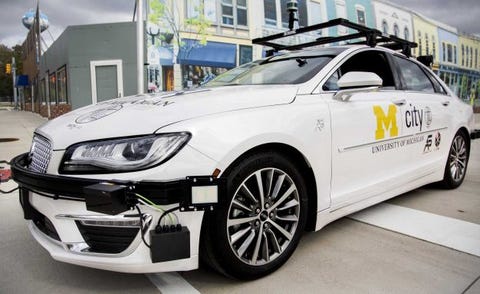Self Balancing Technology

Cruise Automation
Although much about self-driving vehicles remains mired in an uncertain, hotly debated future, one important detail about them seems far less controversial: the assumption that autonomous vehicles eventually will be fully electric. However, those who are developing the cars have to contend with an inconvenient truth: the technology uses a lot of energy.
The suite of sensors, the safety redundancies, and all the added computational power that needs to be onboard makes a vehicle into a massive power hog—which will reduce driving range for electric vehicles or require automakers to pack more (and more expensive) battery capacity into vehicles.
As Bloomberg cites, the supplier BorgWarner estimates that all the gear in development vehicles is the equivalent of having 50 to 100 laptops continuously running in the trunk. If we take the average power use of a laptop to be in the vicinity of 20 watts, that's 1 to 2 kW. In other words, these systems add up to 5 or 10 percent more energy than the vehicle might otherwise use.
The Robots Need Feeding, Too
Of course, those BorgWarner estimates are based on a bulky set of hardware installed onto an existing vehicle—not integrated within it, as would be the case when it's fully implemented. Still, there are some indications that autonomous-vehicle engineers may be so engrossed in the other hurdles of self-driving systems that efficiency slips well down their priority lists. Engineers at one major automaker, for instance, earlier this year couldn't even provide C/Dwith a ballpark figure for the energy consumption of the hardware it's developing for a Level 4 automated-driving system (one in which the vehicle could perform all of the driving, but only in specific scenarios).
That is in sharp contrast to the recent reality of new-vehicle refinements; especially on electric cars, engineers are pressured to keep a hawk's eye on weight as well as the power used by accessories. Automakers routinely boast about the energy savings of LED headlamps; Nissan put special energy-saving "green" premium sound systems on the option lists of the original Leaf.
That energy demand is a bit greater on development cars, confirmed Peter Bergmiller, technical project lead for Audi's piloted driving systems, because it's collecting every bit of data that it can on those vehicles—around 6 GB per minute—and that takes additional hard drives. But it's also greater because of the level of redundancy that goes into these vehicles' core systems. "We're definitely different than the consumer tech industry, which just needs more, more, more; we need safer, safer, safer," he said.

Prominent chip-maker and supplier Nvidia recently revealed a compact, energy-saving supercomputer aimed at fully autonomous taxi applications. Danny Shapiro, Nvidia's senior director of automotive, suggested an even greater level of energy savings than what BorgWarner suggested—on the order of 20 kilowatt-hours over 10 hours, or 20 percent of the 100-kWh battery capacity that looks bound to become the premium electric-vehicle standard (allowing a driving range in many cases of 300 miles or more) over the next few years.
On smaller cars, that would likely take an even heavier toll on range, as the vehicle would still have about the same sensing and processing needs. Even if the energy consumption of such systems adds up to 10 kWh over the course of a charge, that's still potentially about 20 percent of usable range lost on the Chevrolet Bolt EV, for instance.
Not Exactly the EPA Driving Cycle
These revelations highlight some important decisions about self-driving vehicles and energy consumption moving forward. Should all vehicles intended for driving in autonomous modes be rated for their efficiency with those systems fully enabled or not? All those electronics produce waste heat, though—waste heat that could be harnessed to keep the cabin warm in cold weather.

It's a complicated balance, but all signs point to more new efficiency gains than losses from self-driving tech—even at its present power-hog status. The University of Michigan Center for Sustainable Systems, for instance, last year summed up the potential efficiency gains from various aspects of converting to a self-driving economy, including reduced congestion and potential savings in the weight of safety systems if such cars can be engineered not to crash.
If the power demands can't be greatly reduced or reconciled, hybrid or plug-in hybrid powertrains probably make more sense in the near term for vehicles with a taxi-like duty cycle. Engineers don't have a lot of time to resolve these issues; the first robo-taxis, which many companies are pushing hard to develop, could be on the road in limited public deployments in as little as two or three years.
But if for regulatory or technical reasons these deployments are further off—within six or eight years, perhaps—it will be hard to argue with the economics and convenience of electric vehicles. By then battery costs will have fallen further, and depending on the use, these cars could either park themselves overnight over an inductive charging pad or be fast charged at 350 kW or higher (or with new 800V systems) to provide another couple hundred miles of driving within 10 or 15 minutes.
This content is created and maintained by a third party, and imported onto this page to help users provide their email addresses. You may be able to find more information about this and similar content at piano.io
Source: https://www.caranddriver.com/news/a15339401/self-driving-vehicles-may-save-energy-despite-power-hog-tech-on-board/







Tidak ada komentar:
Posting Komentar